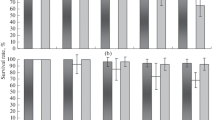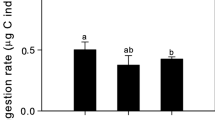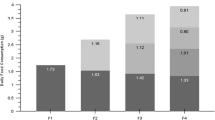Abstract
Observations of gonads and oocyte development stages (OS) have been achieved in Calanus helgolandicus females fed different algal diets and starved in filtered sea water under laboratory conditions during 8 days. The effects of 20 diets on egg production rates (EPR), hatching success (HS) and proportion of abnormal larvae (AL, development stages N1-2) were examined. With the control diet Prorocentrum minimum EPR and HS values were high, while AL was very low, coinciding with intact cell structures in oogonia (OO) and normal OS (OS1-OS4). With the other diets, oocyte maturation, EPR, HS and AL patterns were partially or totally impaired. Decrease of EPR coincided with the arrest of OS3 maturation and oocyte degradations, characterised by cell fragmentation, presence of apoptotic bodies in the OS3, degradation of cytoplasm in OS3 and OS4 and consequently the arrest of OS4 formation. These degradations were reversible when females were fed a favourable diet. Results reflect the presence of two distinct inhibitory mechanisms. Inhibition mechanism (1) impairs egg production. It was induced by starvation or by several species belonging to Bacillariophyceae (Chaetoceros calcitrans, Guinardia delicatula, Guinardia striata, Odontella regia, Rhizosolenia setigera, Stephanopyxis turris, Thalassiosira pseudonana) and mixed-diatom assemblages (collected in the field) and to the prymnesiophyte Pavlova lutherii. Remarkably other diatoms like Navicula sp., Nitzschia sp., Skeletonema costatum and Thalassiosira rotula did not induce mechanism (1) Inhibitory mechanism (2) affected exclusively HS and AL and was triggered by species independent of the production of polyunsaturated aldehydes (PUA), which are supposed to have adverse impacts on HS and larval development.











Similar content being viewed by others
References
Adiyodi RG (1985) Reproduction and its control. The biology of Crustacean, vol 9. Academic, New York, pp 147–215
Andersen HR, Wollenberger L, Halling-Sorensen B, Kusk KO (2001) Development of copepod nauplii to copepodites- a parameter for chronic toxicity including endocrine disruption. Environ Toxicol Chem 2001:2821–2829
Andrade JP, Lee PG (2001) Effects of different food items on the culture of the mysid shrimp Mysidopsis almyra (Crustacea: Pericaridae). Aqua Intern 9:393–400
Arendt KE, Jónasdóttir SH, Hansen PJ, Gartner S (2005) Effects of dietary acids on the reproductive success of the calanoid copepod Temora longicornis. Mar Biol 146:513–530
Ask J, Reinikainen M, Båmstedt U (2006) Variation in hatching success and egg production of Eurytemora affinis (Calanoida, Copepoda) from the Gulf of Bothnia, Baltic Sea, in relation to abundance and clonal differences of diatoms. J Plank Res (in press)
Ban S, Burns C, Castel J, Chaudron Y, Christou E, Escribano R, Fonda Umani S, Gasparini S, Guerrero Ruiz F, Hoffmeyer M, Ianora A, Kang HK, Laabir M, Lacoste A, Miralto A, Ning X, Poulet S, Rodriguez V, Runge J, Shi J, Starr M, Uye S, Wang Y (1997) The paradox of diatom-copepod interactions. Mar Ecol Prog Ser 157:287–293
Barthelemy RM, Cuoc C, Caubit X, Brunet M (2001) The shell glands in some calanoid copepods (Crustacea). Can J Zool 79:1490–1502
Berge J-P, Gouygou J-P, Dubacq J-P, Durand P (1995) Reassessment of lipid composition of the diatom Skeletonema costatum. Phytochemistry 39:1017–1021
Blades-Eckelbarger PI (1986) Aspect of internal anatomy and reproduction in the Copepoda. In: Schriever G, Schminke HK, Shih CT (eds) Prodeedings of the 2nd international conference on Copepoda. 13–17 August 1984, Ottawa. Syllogeous, vol 58. National Museum of Canada, Ottawa, pp 26–50
Blades-Eckelbarger PI, Youngbluth MJ (1984) The ultrastructure of oogenesis and yolk formation in Labidocera aestiva (Crustacea: Copepoda). J Morphol 179:33–46
Broglio E, Jónasdóttir SH, Calbet A, Jakobsen HH, Saiz E (2003) Effect of heterotrophic versus autotrophic food on feeding and reproduction of the calanoid copepod Acartia tonsa: relationship with prey fatty acid composition. Aquat Microb Ecol 31:297–278
Buttino I, Santo MD, Ianora A, Miralto A (2004) Rapid assessment of copepod (Calanus helgolandicus) embryo viability using fluorescent probes. Mar Biol 145:393–399
Castellani C, Altunbas Y (2006) Factors controlling the temporal dynamics of egg production in the copepod Temora longicornis. Mar Ecol Prog Ser 308:143–153
Cuoc C, Brunet M, Arnaud J, Mazza J (1994) Formation of egg envelopes in the freshwater calanoid copepod, Hemidiaptomus ingens. Invertebr Reprod Dev 26:63–78
De Loof A, Baggerman G, Breuer M, Claeys I, Cerstiaens A, Clynen E, Janssen T, Schoofs L, Vanden Broeck J (2001) Gonadotropins in insects: an overwiev. Arch Insect Biochem Physiol 47:129–138
Delaunay F, Marty Y, Moal J, Samain J-F (1993) The effect of monospecific algal diets on growth and fatty composition of Pecten maximux (L.) larvae. J Exp Mar Biol Ecol 173:163–179
Dupuy C, Vaquer A, Lam-Höai T, Rougier C, Mazouni N, Lautier J, Collos Y, Le Gall S (2000) Feeding rate of the oyster Crassostrea gigas in a natural planktonic community of the Mediterranean Thau lagoon. Mar Ecol Prog Ser 205:171–184
Halsband-Lenk C, Pierson JJ, Leising AW (2005) Reproduction of Pseudocalanus newmani (Copepoda: CAlanoida) is deleteriously affected by diatoms blooms-A field study. Prog Oceanogr 67:332–348
Hasset RP (2004) Supplementation of a diatom diet with cholesterol can enhance copepod egg-production rates. Limnol Oceanogr 49:488–494
Ianora A, Poulet SA (1993) Egg viability in the copepod Temora stylifera. Limnol Oceanogr 38:1615–1626
Ianora A, Poulet SA, Miralto A (2003) The effects of diatoms on copepod reproduction: a review. Phycologia 42:351–363
Ianora A, Miralto A, Poulet SA, Carotenuto Y, Buttino I, Romano G, Casotti R, Pohnert G, Wichard T, Colucci-D’Amato L, Terrazzano G, Smetacek V (2004a) Aldehyde suppression of copepod recruitment in blooms of an ubiquitous planktonic diatom. Nature 429:403–407
Ianora A, Turner JT, Esposito F, Carotenuto Y, d’Ippolito G, Romano G, Fontana A, Guisande C, Miralto A (2004b) Copepod egg production and hatching success is reduced by maternal diets of a non-neurotoxic strain of the dinoflagellate Alexandrium tamarense. Mar Ecol Prog Ser 280:199–2120
Irigoien X, Harris RP, Verheye HM, Joly P, Runge J, Starr M, Pond D, Campbell R, Shreeve R, Ward P, Smith AN, Dam HG, Peterson W, Tirelli V, Koski M, Smith T, Harbour D, Davidson R (2002) Copepod hatching success in marine ecosystems with high diatom concentrations. Nature 419:387–389
Jónasdóttir SH (1994) Effects of food quality on the reproductive success of Acartia tonsa and Acartia hudsonica: laboratory observations. Mar Biol 121:67–81
Kang HK, Poulet SA (2000) Reproductive success in Calanus helogolandicus as a function of diet and egg cannibalism. Mar Ecol Prog Ser 201:241–250
Kerr JFR, Wyllie AH, Currie AR (1972) Apoptosis: a basic biological phenomenon with wide-ranging implications in tissue kinetics. Br J Cancer 26:239–257
Koski M (2007) High reproduction of Calanus finmarchicus during a diatom-dominated spring bloom. Mar Biol (in press)
Laabir M, Poulet SA, Ianora A (1995) Measuring production and viability of eggs in Calanus helgolandicus. J Plankton Res 17:1125–1142
Lacoste A, Poulet SA, Cuef A, Kattner G, Ianora A, Laabir M (2001) New evidence of the copepod maternal food effects on reproduction. J Exp Mar Biol Ecol 259:85–107
Lee HW, Ban S, Ando Y, Ota T, Ikeda T (1999) Deleterious effect of diatom diets on egg production and hatching success in the marine copepod Pseudocalanus newmani. Plankton Biol Ecol 46:104–112
Maps F, Runge JA, Zakardjian B, Joly P (2005) Egg production and hatching success of Temora longicornis (Copepoda, Calanoida) in the southern Gulf of St. Lawrence. Mar Ecol Prog Ser 285:117–128
Matova N, Cooley L (2001) Comparative aspects of animal oogenesis. Dev Biol 231:291–320
Mauchline J (1998) The biology of calanoid copepods. Adv Mar Biol 33:710
Meuzy JJ, Payen GG (1988) Female reproduction in malacostracan Crustacea. Zool Sci 5:217–265
Miralto A, Barone G, Romano G, Poulet SA, Ianora A, Russo GL, Buttino I, Mazzarella G, Laabir M, Cabrini M, Giacobbe MG (1999) The insidious effect of diatoms on copepod reproduction. Nature 402:173–176
Miralto A, Guglielmo L, Zagami G, Buttino I, Granata A, Ianora A (2003) Inhibition of population growth in the copepods Acartia clausi and Calanus helgolandicus during diatom blooms. Mar Ecol Prog Ser 254:253–268
Nezis IP, Modes V, Mpakou V, Stravopodis DM, Papassideri IS, Mammali I, Margaritis LH (2003) Modes of programmed cell death during Ceratis capitata oogenesis. Tissue Cell 35:113–119
Niehoff B (1998) The gonad morphology and maturation in Arctic Calanus species. J Mar Syst 15:53–59
Niehoff B (2003) Gonad morphology and oocyte development in Pseudocalanus spp. in relation to spawning activity. Mar Biol 143:759–768
Niehoff B (2004) The effect of food limitation on gonad development and egg production of the planktonic copepod Calanus finmarchicus. J Exp Mar Biol Ecol 307:237–259
Niehoff B, Hirche HJ (1996) Oogenesis and gonad maturation in the copepod Calanus finmarchicus and the prediction of egg production from preserved samples. Polar Biol 16:601–612
Niehoff B, Schnack-Schiel S, Cornils A, Brichta M (2002) Reproductive activity of two dominant Antarctic copepod species, Metridia gerlachei and Ctenocalanus citer, in late autumn in the eastern Bellingshausen Sea. Polar Biol 25:583–590
Paffenhöfer G, et al (2005) Colloquium on diatom-copepod interactions. Mar Ecol Prog Ser 286:293–305
Pohnert G (2005) Diatom/Copepod interactions in plankton: the indirect chemical defense of unicellular algae. ChemBioChem 6:946–959
Pohnert G, Lumineau O, Cueff A, Adolph S, Cordevant C, Lange M, Poulet SA (2002) Are volatile unsaturated aldehydes from diatoms the main line of chemical defence against copepods? Mar Ecol Prog Ser 245:33–45
Pond D, Harris R, Head R, Harbour D (1996) Environmental and nutritional factors determining seasonal variability in the fecundity and egg viability of Calanus helgolandicus in coastal waters off Plymouth, UK. Mar Ecol Prog Ser 143:45–63
Poulet SA, Ianora A, Miralto A, Meijer L (1994) Do diatoms arrest embryonic development in copepods? Mar Ecol Prog Ser 111:79–96
Poulet SA, Laabir M, Ianora A, Miralto A (1995) Reproductive response of Calanus helgolandicus. I. Abnormal embryonic and naupliar development. Mar Ecol Prog Ser 129:85–95
Poulet SA, Richer de Forge M, Cueff A, Lennon J-F (2003) Double labelling methods used to diagnose apoptotic and necrotic cell degradations in copepod nauplii. Mar Biol 143:889–895
Poulet SA, Wichard T, Ledoux JB, Lebreton B, Marchetti J, Dancie C, Bonnet D, Cueff A, Morin P, Pohnert G (2006) Influence of diatoms on copepod reproduction. I. Field and laboratory observations related to Calanus helgolandicus egg production Mar Ecol Prog Ser 308:129–142
Pounds NA, Hutchinson TH, Williams TD, Whiting P, Dinan L (2002) Assessment of putative endocrine disrupters in an in vivo crustacean assay and an in vitro insect assay. Mar Environ Res 54:709–713
Razouls S (1974) Maturité sexuelle et fécondité chez la femelle de Temora stylifera, copépode pélagique (Copepoda Calanoida). Arch Zool Exp Gen 115:387–399
Razouls S, Nival P, Nival S (1987) Development of the genital system in the copepod stages of the calanoid copepod Temora stylifera Dana. J Mar Biol Assoc UK 67:653–661
Razouls S, Razouls C, Huntley M (1991) Development and expression of sexual maturity in female Calanus pacificus (Copepoda Calanoida) in relation to food quality. Mar Biol 110:65–74
Runge JA (1987) Measurements of egg production rate of Calanus finmarchicus from preserved samples. Can J Fish Aquat sci 44:2009–2012
Tsukimura B (2001) Crustacean vitellogenesis: its role in oocyte development. Am Zool 41:465–476
Turner JT, Ianora A, Miralto A, Laabir M, Esposito F (2001) Decoupling of copepod grazing rates, fecundity and egg-hatching success on mixed and alternating diatom and dinoflagellate diets. Mar Ecol Prog Ser 220:187–199
Vargas C, Escribano R, Poulet SA (2006) Phytoplankton food quality determines time-windows for successful zooplankton reproductive pulses. Ecology 87:2992–2999
Verity PG, Robertson CY, Tronzo CR, Andrews MG, Nelson JR, Sieracki ME (1992) Relationship between cell volume and the carbon and nitrogen content of marine photosynthetic nanoplankton. Limnol Oceanogr 37:1434–1446
Wichard T, Poulet SA, Halsband-Lenk C, Albaina A, Harris R, Liu DY, Pohnert G (2005) Survey of the chemical defence potential of diatoms: screening of fifty one species for α,β,γ,δ-unsaturated aldehydes. J Chem Ecol 31:949–958
Wichard T (2006) Investigation of lipoxygenase mediated chemical defences: Diatom and Physcomitrella patens derived oxylipins. Ph.D. Thesis, Friedrich-Schiller-University Jena, Germany
Wichard T, Gerecht A, Boersma M, Poulet SA, Wiltshire K, Pohnert G (2007) Lipid and fatty acid composition of diatoms revisited: rapid wound activated change of food quality parameters influences herbivorous copepod reproductive success. Provisionally accepted by ChemBioChem
Wiltshire KH, Dürselen C-D (2004) Revision and quality analyses of the Helgoland Reede long-term phytoplankton data archive. Helgol Mar Res 58:252–268
Wyllie AH, Kerr JFR, Currie AR (1980) Cell death: the significance of apoptosis. Int Rev Cytol 68:251–306
Acknowledgements
This article is dedicated to the late Alain Maron and to Jean-Michel Roualec, who are gratefully acknowledged for their great professional assistance and reliability for collecting water and zooplankton samples at sea during so many years. This work was partly funded by CNRS and the French program “Biodiversité et Changement Global”. We deeply acknowledge Marc Blondel for sharing his Olympus microscope.
Author information
Authors and Affiliations
Corresponding author
Additional information
Communicated by O. Kinne.
Rights and permissions
About this article
Cite this article
Poulet, S.A., Cueff, A., Wichard, T. et al. Influence of diatoms on copepod reproduction. III. Consequences of abnormal oocyte maturation on reproductive factors in Calanus helgolandicus . Mar Biol 152, 415–428 (2007). https://doi.org/10.1007/s00227-007-0701-5
Received:
Accepted:
Published:
Issue Date:
DOI: https://doi.org/10.1007/s00227-007-0701-5




